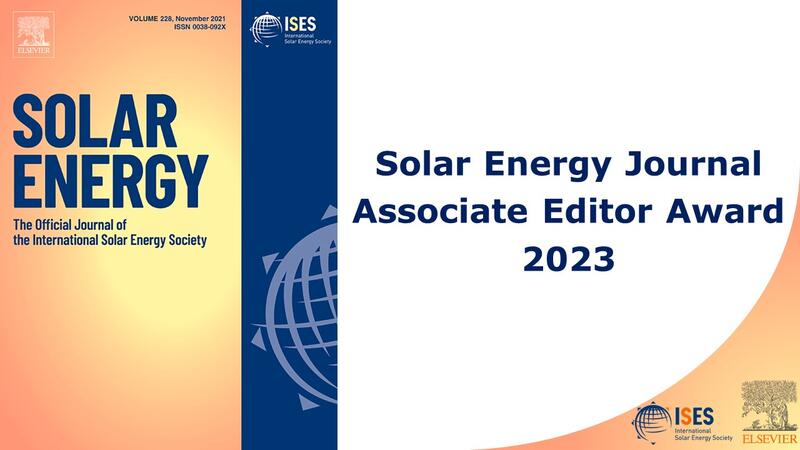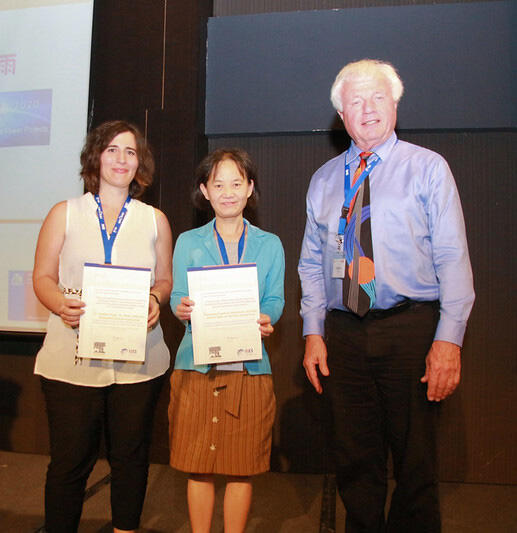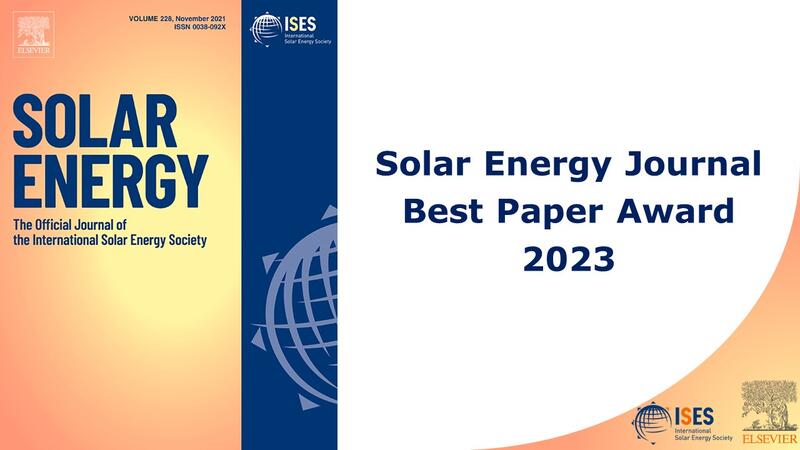Solar Energy Journal Awards
Best Paper Award
The award was initiated in 1981, at that time it was called the Löf/Duffie Best Paper Award, and since 2007 has been called the "Solar Energy Journal Best Paper Award". The award is presented to authors of papers considered to be outstanding contributions published in the ISES scientific journal, "Solar Energy". The award is presented to papers that demonstrate significant pioneering contributions to the solar energy literature, for innovative concepts or approaches, and whose quality and presentation have a lasting impact. The papers chosen for this award are selected by the Editor-in-Chief, Subject Area Editors and Associate Editors of the Solar Energy Journal. The award consists of a certificate and a small cash prize funded by Elsevier.
Associate Editor of the Year Award
With this award, Solar Energy recognizes the dedication and commitment of the Associate Editors to promoting the Journal and ensuring the high quality of the articles published. The Journal further recognizes that overseeing the scientific review process in a timely manner takes significant effort and coordination. Therefore, the Journal recognizes annually one or more Associate Editor(s) with the Associate Editor of the Year Award, which includes a certificate and the opportunity for the awardee to have one peer-reviewed article published in Solar Energy open access for 6 months free of charge. The Associate Editor(s) of the Year is/are selected by the Editor-in-Chief based on nominations received from the Subject Area Editors.
Associate Editor of the Year Award - 2023

Solar Heating/ Cooling and Buildings - Dr. Anna Laura Pisello (Italy)
Dr. Pisello is an associate professor of environmental applied physics at University of Perugia, Italy where she founded the Environmental Applied Physics Lab. She has been a visiting research associate at Princeton University (NJ), Columbia University (NY), Virginia Tech (Virginia) and City University of New York.
She is the author of more than 150 international refereed journal publications and several patents about microclimate monitoring systems, new materials for radiative cooling and photoluminescence. Dr Pisello has won several international academic awards and European projects under the framework of Horizon 2020 and Horizon Europe program including one European Research Council grant about radiative cooling for urban heat mitigation, as the first and only Italian scientist in the field of Environmental/Industrial Applied Physics. She is an associate editor of Solar Energy (Elsevier), editor of Energy and Buildings (Elsevier) and Nature Scientific Reports, among others.
Photovoltaic Cells and Cell Physics - Dr. Lingamallu Giribabu (India)
Dr. Giribabu is a Senior Scientist at the CSIR-Indian Institute of Chemical technology (IICT), Hyderabad, India, and a Professor at the Academy of Scientific and Innovation Research (AcSIR).
His expertise is in the design and development of low-cost materials that include sensitizers, redox couples, electrode materials, semi-conducting metal oxides, and hole transport materials for dye-sensitized solar cells and perovskite solar cells. His group also investigates donor-acceptor systems-based pigment molecules for bio-mimicking of natural photosynthesis, non-linear optical properties as well as sensitizers for photodynamic therapy. He is the recipient of several awards including the Materials Research Society award, a Fellow of the Royal Society of Chemistry, and a Fellow of the Luminescence Society of India. He has published over 250 research articles, is an inventor on 7 patents and has published six book chapters.
Concentrating Solar Power and High Temperature Processes - Dr. Robert Pitz-Paal (Germany)
Dr. Pitz-Paal is one of the two directors of DLR Solar Research Institute, the largest research institution in Germany working in the field of concentrating solar technologies. This position is jointly assigned with a professorship at Aachen University.
His main research areas are the technical analysis and optimization of concentrating solar power systems for generating electricity and producing fuel. Many innovations developed in his institute can be found today in commercial solar thermal power plants. Dr Pitz-Paal has serves as associate editor the Journal of Solar Energy and served as the chairman of the SolarPACES technology Cooperation Programme of the IEA form 2017 -21. He is also member of the board of the German Industry Association of CSP (DeutscheCSP) and of the European Industry Association ESTELA. Pitz-Paal received the Farrington-Daniels Award of the International Energy Society in 2017 and the Frank Kreith Energy Award of the ASME in 2020.
Best Papers 2021
CSP
The influence of atmospheric boundary layer turbulence on the design wind loads and cost of heliostats
https://doi.org/10.1016/j.solener.2020.07.022
Matthew J. Emes; Azadeh Jafari; Joe Coventry; Maziar Arjomandi
Photocatalysis
Recent advances in partially and completely derived 2D Ti3C2 MXene based TiO2 nanocomposites towards photocatalytic applications: A review
https://doi.org/10.1016/j.solener.2021.05.010
Adem Sreedhar; Jin-Seo Noh
Photovoltaics
Efficient fully roll-to-roll coated encapsulated organic solar module for indoor applications
https://doi.org/10.1016/j.solener.2021.03.025
Bárbara H.S. Miranda; Luiza de Q.Corrêa; Gabriela A.Soares; Juliana L.Martins; Paulo L.Lopes; Maria L.Vilela; Jair F.Rodrigues; Thainá G.Cunha; Rodrigo de Q.Vilaça; Sergio Castro-Hermosa; Luana Wouk; Diego Bagnis
PV Systems, Grid Integration
Stabilization of light-induced effects in Si modules for IEC 61215 design qualification
https://doi.org/10.1016/j.solener.2020.08.025
L. Repins; F. Kersten; B. Hallam; K. Van Sant; M.B. Koentopp;
Solar Heating and Cooling, Buildings
Integration of passive double-heating and double-cooling system into residential buildings (China) for energy saving
https://doi.org/10.1016/j.solener.2021.08.020
Fang'ai Chi; Ruonan Wang; Yonghe Wang;
Solar Resource
An efficient method to identify uncertainties of WRF-Solar variables in forecasting solar irradiance using a tangent linear sensitivity analysis
https://doi.org/10.1016/j.solener.2021.03.044
Jaemo Yang; Ju-Hye Kim; Pedro A. Jiménez; Manajit Sengupta; Jimy Dudhia; Yu Xie; Anastasios Golnas; Ralf Giering
Best Papers 2018-2019

Best Paper on the topic of Solar Heating and Cooling, Buildings and Other
“Solar assisted heat pump system for multifamily buildings: Towards a seasonal performance factor of 5? Numerical sensitivity analysis based
on a monitored case study”
Carolina Fraga, Pierre Hollmuller, Floriane Mermoud, and Bernard Lachal
Best Paper on the topic of Photovoltaics
“Relevance of PV with single-axis tracking for energy scenarios"
Svetlana Afanasyeva, Dmitrii Bogdanov, and Christian Breyer
Best Paper on the topic of Resources and Meteorology (Co-winners--tie)
1) “Surface albedo and reflectance: Review of definitions, angular and spectral effects, and intercomparison of major data sources in support of advanced solar irradiance modeling over the Americas”
Christian A. Gueymard, Vicente Lara-Fanego, Manajit Sengupta, and Yu Xie
2) “Surface solar radiation forecasts by advecting cloud physical properties derived from Meteosat Second Generation observations”
Ping Wang, Rudolf van Westrhenen, Jan Fokke Meirink, Sibbo van der Veen, and Wouter Knap
Best Paper on the topic of Solar Environmental, Photocatalytic, and New Areas
“Cobalt-doped nickel oxide nanoparticles as efficient hole transport materials for low-temperature processed perovskite solar cells,”
Ryuji Kaneko, Towhid H. Chowdhury, Guohua Wu, Md. Emrul Kayesh, Said Kazaoui, Kosuke Sugawa, Jae-Joon Lee, Takeshi Noda, Ashraful Islam, and Joe Otsuki.
Best Paper on the topic of Concentrating Solar Power and High Temperature Processes
No nomination this year.
Best Papers 2016 - 2017
Concentrated Solar Power
“The morphological stability and fuel production of commercial fibrous ceria particles for solar thermochemical redox cycling”
Adam C. Gladen, Jane H. Davidson
Department of Mechanical Engineering, University of Minnesota, Minneapolis, MN United States
Photovoltaics
“Progress in research on the stability of organometal perovskite solar cells”
Mahboobeh Shahbazi, Hongxia Wang
School of Chemistry, Physics and Mechanical Engineering, Queensland University of Technology, Brisbane, Australia
Solar Resources / Meteorology
“QCPV: A quality control algorithm for distributed photovoltaic array
power output”
Sven Killinger, Nicholas Engerer, Björn Müller
Fraunhofer, et al., Germany
Solar Thermal / Heating / Cooling
“Energy conservation and renewable technologies for buildings to face
the impact of the climate change and minimize the use of cooling”
Fabrizio Ascione
University of Napoli Federico II, DII – Department of Industrial Engineering, Piazzale Tecchio, 80, 80125 Napoli, Italy
Best Papers 2014-2015
Thermal collectors
“High temperature and long-term stability of carbon nanotube nanofluids for direct absorption solar thermal collectors”
Hordy; Solar Energy, Volume 105, July 2014, Pages 82-90
PV
“High performing extraction procedure for the one-diode model of a photovoltaic panel from experimental I-V curves by using reduced forms”
Laudani, Fulginei, Salvini; Vol. 103, May 2014, pp. 316-326
Solar Resource
“Characterizing Local High-Frequency Solar Variability and its Impact to Distribution Studies”
Lave, Reno, Broderick; Vol. 118, August 2015, pp. 327-337
CSP
“Fast computation of solar concentrating ratio in presence of opto-mechanical errors”
François Hénault, Volume 112, February 2015, pp 183-193
Solar Cooling
“Solar energy potential on roofs and facades in an urban landscape”
Redweik, Catita, Brito; Vol. 97, November 2013, pp. 332-341
The winners were recognized and presented with a Best Paper certificate at the ISES Solar World Congress 2015 (November, Daegu, Korea).
The Solar Energy Best Paper Awards are presented by ISES and the publisher Elsevier, which also sponsors a cash prize presented to the lead authors of each winning paper.
Best Papers 2013
Solar Radiation and Solar Resource Assessment
"Deriving cloud velocity from an array of solar radiation measurements" by J.L. Bosch, Y. Zheng, J. Kleissl, Volume 87, January 2013, Pages 196-203.
Daylighting
"Dual waveguide patterned luminescent solar concentrators", by Peter T.M. Albers, Cees W.M. Bastiaansen, Michael G., Volume 95, September 2013, Pages 216-223.
Solar Radiation and Solar Resource Assessment
"Intra-Hour DNI Forecasting Based on Cloud Tracing Image Analysis", by Ricardo Marquez, Carlos FM Coimbra, Volume 91, May 2013, Pages 327-336.
Collector Technology
"Novel black selective coating for tubular solar absorbers based on a sol-gel method". by Martin Joly, Yannik Antonetti, Martin Python, Marina Gonzalez, Thomas Gascou, Jean-Louis Scartezzini, Andreas Schüler, Volume 94, August 2013, Pages 233-239.
High Concentration/Solar Thermal Power
"Performance of compound parapolic concentrators with polygonal Aperture", by Thomas Cooper, Fabian Dähler, Gianluca Ambrosetti, Andrea Pedretti, Aldo Steinfeld, Volume 95, September 2013, Pages 308-318.
Solar Radiation and Resource Assessment
"Relationship between Sunshine Duration and Solar Radiation", by Harry Suehrcke, Ross S. Bowden, K.G.T. Hollands, Volume 92, June 2013, Pages 160-171.
The Solar Energy journal also presented a special award to the paper with the most downloads from 2011-2013. The paper is:
Most downloaded
"Solar Photovoltaic Electricity: Current Status And Future Prospects" by T.M. Razykov, C.S. Ferekides, D. Morel, E. Stefanakos, H.S. Ullal, H.M. Upadhyaya, Volume 85, Issue 8, August 2011, Pages 1580-1608.
Best Paper Awards 2023

PV Cells and Cell Physics
- Stable and efficient Sb2Se3 solar cells with solution-processed NiOx hole-transport layer by Liping Guo, S. N. Vijayaraghavan, Xiaomeng Duan, Harigovind G. Menon, Jacob Wall, Lingyan Kong, Subhadra Gupta, Lin Li, Feng Yan - Solar Energy, Volume 218, 2021, 525-531 - https://doi.org/10.1016/j.solener.2021.02.063
Solar Heating & Cooling, Buildings
- Improving the performance of tubular solar still integrated with drilled carbonized wood and carbon black thin film evaporation by Swellam W Sharshir, AW Kandeal, Youssef M Ellakany, Ibrahem Maher, Ahmed Khalil, Ahmed Swidan, Gamal B Abdelaziz, Hany Koheil, Maher Rashad - Solar Energy, Volume 233, 2022, 504-514 - https://doi.org/10.1016/j.solener.2022.01.065
- Investigation of physico-mechanical, thermal properties and solar thermoregulation performance of shape-stable attapulgite based composite phase change material in foam concrete by Osman Gencel, Abid Ustaoglu, Ahmet Benli, Gökhan Hekimoğlu, Ahmet Sarı, Ertugrul Erdogmus, Mucahit Sutcu, Gökhan Kaplan, Oguzhan Yavuz Bayraktar - Solar Energy, Volume 236, 2022, 51-62 - http://doi.org/10.1016/j.solener.2022.02.042
CSP & Photochemistry
- A feasibility study on the application of mesh grids for heliostat wind load reduction by Matthew J. Emes, Azadeh Jafari, Maziar Arjomandi - Solar Energy, Volume 240, 2022, 121-130 - https://doi.org/10.1016/j.solener.2022.05.033
Solar Resources
- IrradianceNet: Spatiotemporal deep learning model for satellite-derived solar irradiance short-term forecasting by Andreas H Nielsen, Alexandros Iosifidis, Henrik Karstoft - Solar Energy, Volume 228, 2021, 659-669 - https://doi.org/10.1016/j.solener.2021.09.073
Systems Integration
- Modeling, testing, and mitigation of electromagnetic pulse on PV systems by Wei Qiu, Liang Zhang, He Yin, Lawrence C Markel, Dahan Liao, Ben W McConnell, Yilu Liu - Solar Energy, Volume 264, 2023, 112010 - https://doi.org/10.1016/j.solener.2023.112010
- Techno-economic potential and perspectives of floating photovoltaics in Europe by Leonardo Micheli, Diego L Talavera, Giuseppe Marco Tina, Florencia Almonacid, Eduardo F Fernández - Solar Energy, Volume 243, 2022, 203-214 - https://doi.org/10.1016/j.solener.2022.07.042